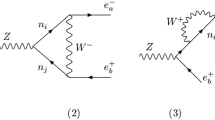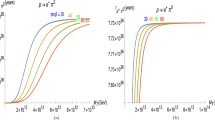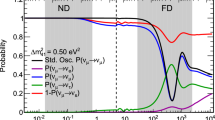Abstract
We analyze neutrino masses and Lepton Flavor Violation (LFV) in charged leptons with a minimal ansatz about the breaking of the U(3)5 flavor symmetry, consistent with the U(2)3 breaking pattern of quark Yukawa couplings, in the context of supersymmetry. Neutrino masses are expected to be almost degenerate, close to present bounds from cosmology and 0νββ experiments. We also predict s 13≈s 23|V td |/|V ts |≈0.16, in perfect agreement with the recent Daya-Bay result. For slepton masses below 1 TeV, barring accidental cancellations, we expect \(\mathcal{B}(\mu\to e \gamma) > 10^{-13}\) and \(\mathcal {B}(\tau\to\mu\gamma) > 10^{-9}\), within the reach of future experimental searches.







Similar content being viewed by others
Notes
We denote in bold U(3) vectors and representations.
This has no practical implications if we consider the Yukawa sector alone, where there in no preferred O(2) subgroup of U(2) l in the limit V→0.
For quarks, it was shown in [11] that the CKM phase is entirely defined by the phases in the ΔY f spurions. Thus, the conclusions for the quark sector would remain unchanged.
The physical phase appearing in the CKM matrix can be determined in terms of α d −α u [11], but we cannot disentangle α d and α u without extra theoretical assumptions.
The WMAP bound of [26] for the sum of neutrino masses varies between 1.3 eV (WMAP-only) and 0.58 (WMAP + Baryon Acoustic Oscillations + Hubble constant measurements).
In the diagonalization process we discard results with tachyonic sleptons or charged LSPs. We also take into account the approximate LEP bounds on chargino, stau and sneutrino masses [34].
References
R.S. Chivukula, H. Georgi, Phys. Lett. B 188, 99 (1987)
G. D’Ambrosio, G.F. Giudice, G. Isidori, A. Strumia, Nucl. Phys. B 645, 155–187 (2002). arXiv:hep-ph/0207036
S. Dimopoulos, G.F. Giudice, Phys. Lett. B 357, 573 (1995). arXiv:hep-ph/9507282
A.G. Cohen, D.B. Kaplan, A.E. Nelson, Phys. Lett. B 388, 588 (1996). arXiv:hep-ph/9607394
M. Papucci, J.T. Ruderman, A. Weiler, arXiv:1110.6926
B.C. Allanach, B. Gripaios, arXiv:1202.6616
N. Craig, D. Green, A. Katz, J. High Energy Phys. 1107, 045 (2011). arXiv:1103.3708
A. Delgado, M. Quiros, Phys. Rev. D 85, 015001 (2012). arXiv:1111.0528
G. Larsen, Y. Nomura, H.L.L. Roberts, arXiv:1202.6339
N. Craig, S. Dimopoulos, T. Gherghetta, arXiv:1203.0572
R. Barbieri, G. Isidori, J. Jones-Perez, P. Lodone, D.M. Straub, Eur. Phys. J. C 71, 1725 (2011). arXiv:1105.2296
M. Dine, R.G. Leigh, A. Kagan, Phys. Rev. D 48, 4269 (1993). arXiv:hep-ph/9304299
A. Pomarol, D. Tommasini, Nucl. Phys. B 466, 3 (1996). arXiv:hep-ph/9507462
R. Barbieri, G.R. Dvali, L.J. Hall, Phys. Lett. B 377, 76 (1996). arXiv:hep-ph/9512388
R. Barbieri, L.J. Hall, A. Romanino, Phys. Lett. B 401, 47 (1997). arXiv:hep-ph/9702315
R. Barbieri, P. Campli, G. Isidori, F. Sala, D.M. Straub, Eur. Phys. J. C 71, 1812 (2011). arXiv:1108.5125
A. Crivellin, L. Hofer, U. Nierste, arXiv:1111.0246
R. Barbieri, D. Buttazzo, F. Sala, D.M. Straub, arXiv:1203.4218
M. Redi, arXiv:1203.4220
S.L. Glashow, arXiv:1106.3319
S. Weinberg, Phys. Rev. Lett. 43, 1566 (1979)
K. Nakamura et al. (PDG Collaboration), J. Phys. G 37, 075021 (2010)
F.P. An et al. (DAYA-BAY Collaboration), arXiv:1203.1669
T. Schwetz, M. Tortola, J.W.F. Valle, New J. Phys. 13, 109401 (2011). arXiv:1108.1376
G.L. Fogli, E. Lisi, A. Marrone, A. Palazzo, A.M. Rotunno, Phys. Rev. D 84, 053007 (2011). arXiv:1106.6028
E. Komatsu et al. (WMAP Collaboration), Astrophys. J. Suppl. Ser. 192, 18 (2011). arXiv:1001.4538 [astro-ph.CO]
J.J. Gomez-Cadenas, J. Martin-Albo, M. Sorel, P. Ferrario, F. Monrabal, J. Munoz-Vidal, P. Novella, A. Poves, J. Cosmol. Astropart. Phys. 1106, 007 (2011). arXiv:1010.5112
S. Plaszczynski, PoS IDM 2010, 066 (2011). arXiv:1012.2215 [astro-ph.CO]
The KamLAND-Zen Collaboration, arXiv:1201.4664
C. Arnaboldi et al. (CUORICINO Collaboration), Phys. Rev. C 78, 035502 (2008). arXiv:0802.3439
R. Arnold et al. (NEMO Collaboration), Phys. Rev. Lett. 95, 182302 (2005). arXiv:hep-ex/0507083
H.V. Klapdor-Kleingrothaus, I.V. Krivosheina, Mod. Phys. Lett. A 21, 1547 (2006)
J. Adam et al. (MEG Collaboration), Phys. Rev. Lett. 107, 171801 (2011). arXiv:1107.5547
LEP2 SUSY Working Group: http://lepsusy.web.cern.ch/lepsusy/www/sleptons_summer04/slep_final.html
B. Aubert et al. (BABAR Collaboration), Phys. Rev. Lett. 104, 021802 (2010). arXiv:0908.2381
V. Cirigliano, B. Grinstein, G. Isidori, M.B. Wise, Nucl. Phys. B 728, 121 (2005). arXiv:hep-ph/0507001
S. Davidson, F. Palorini, Phys. Lett. B 642, 72 (2006). arXiv:hep-ph/0607329
M.B. Gavela, T. Hambye, D. Hernandez, P. Hernandez, J. High Energy Phys. 0909, 038 (2009). arXiv:0906.1461
R. Alonso, G. Isidori, L. Merlo, L.A. Munoz, E. Nardi, J. High Energy Phys. 1106, 037 (2011). arXiv:1103.5461
Acknowledgements
This work was supported by the EU ERC Advanced Grant FLAVOUR (267104), and by MIUR under contract 2008XM9HLM. G.I. acknowledges the support of the Technische Universität München—Institute for Advanced Study, funded by the German Excellence Initiative.
Author information
Authors and Affiliations
Corresponding author
Rights and permissions
About this article
Cite this article
Blankenburg, G., Isidori, G. & Jones-Pérez, J. Neutrino masses and LFV from minimal breaking of U(3)5 and U(2)5 flavor symmetries. Eur. Phys. J. C 72, 2126 (2012). https://doi.org/10.1140/epjc/s10052-012-2126-7
Received:
Revised:
Published:
DOI: https://doi.org/10.1140/epjc/s10052-012-2126-7




